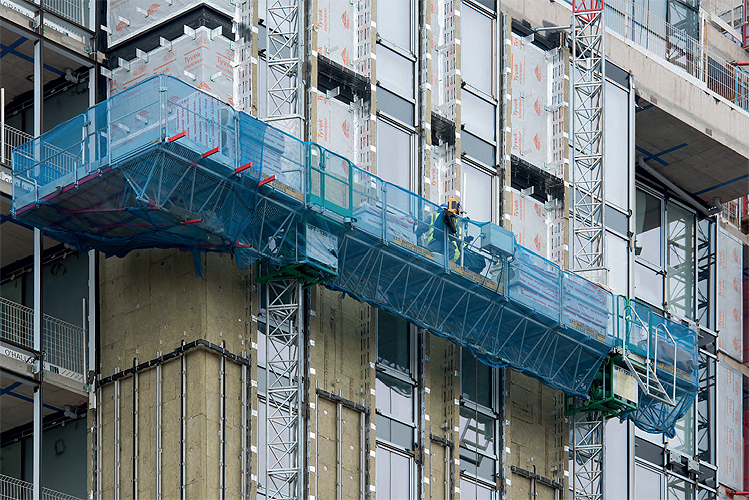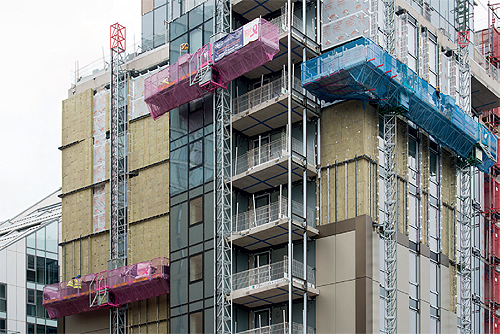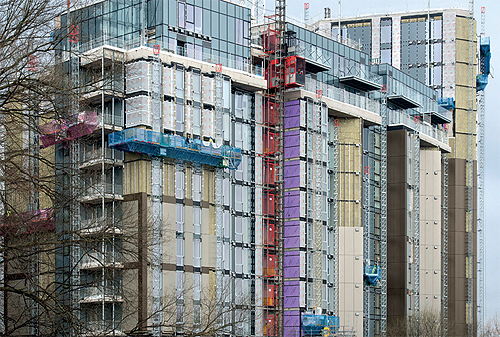
BFT Mastclimbing
New heights
Innovation in the construction industry is all about building on fresh ideas and BFT Mastclimbing is determined to raise the bar in safety and efficiency
You might have wondered, whilst walking past a building under construction, how the workers manoeuvring across the scaffolding skeleton are able to do so safely. Over the years as buildings have become taller and taller, so too has the risk of on-site builder injuries, which is why BFT Mastclimbing advocate the use of mast climbing work platforms. Having begun as a scaffolding company in 1997, the business boasts in its experience and expertise in the use of mast climbers; an elevating work platform that is fixed to either single or twin vertical masts  and travels up and down the masts using an automated power unit. Now, with approximately 1800 units in its fleet, BFT is the largest mast climbing work platform provider in the UK. The company’s Head of Sales, Rob Munns as well as its Safety, Health, Environment and Quality Director, Steve McEwan, talk to us about BFT’s emphasis on in-house training and raising awareness of the mast climbing benefits for the construction industry.
and travels up and down the masts using an automated power unit. Now, with approximately 1800 units in its fleet, BFT is the largest mast climbing work platform provider in the UK. The company’s Head of Sales, Rob Munns as well as its Safety, Health, Environment and Quality Director, Steve McEwan, talk to us about BFT’s emphasis on in-house training and raising awareness of the mast climbing benefits for the construction industry.
“We first started out as a scaffolding company (hence Boards Fittings & Tubes), but after attending a job in Luton, where we built a load-bearing gantry for mast climbers to sit on, we realized what a great bit of kit these machines were. As the company supplying these was based in Scotland and really struggling with the logistics, we saw the opportunity and committed immediately. After serious sustained investment, we now have the ability to support hundreds of projects up and down the county,” shares Rob.
It comes as no surprise that the construction industry is built on ancient traditions, and scaffolding is said to date as far back as the Palaeolithic era of cave painting. Evidence also suggests that Egyptians used wooden scaffolding to support the construction of the Great Pyramids. With such an extensive history, it is understandable why some contractors are reluctant to part from what they have always known. On the flipside, it is also an industry that pursues innovation for efficient solutions. This is how BFT believes mast climbing can marry both tradition and forward thinking. Rob says: “A façade could be 20 by 30 metres for a ten-storey building, and we can erect a twin mast to give full access across that building in two days, whereas scaffolding could take over two weeks to complete. Furthermore, by the time you dial in the site, preliminary costs and commercial comparisons are heavily in favour of mast climbers. This may be new to some people who have always used scaffolding but this is a very viable alternative that they should absolutely consider, as early engagement is crucial to really align with the program, and generate further efficiencies.”
However, like most construction work, it can be risky business to have a group of people negotiating access to the façade of a building, but according to BFT, the most impressive benefit to this line of work platform is its safety. Robert adds that with different parts constantly on the move across a construction site, it can be quite dangerous to have six people at any given time waving metal tubes around as they work to raise the height of the scaffolding. However, if complete access to the façade has been installed within two days, there are less chances of accidents. “The advantage of using a mast climber, even for heavy duty work, means that the tradesmen are always at exactly the right height, that way you avoid lifting and stretching, and the platform can be tailored to the exact dimensions required for the building,” he declares.
Both him and Steve agree that the flexibility of mast climbing gives the operation the ability to scale a building efficiently and cost-effectively. “There is no such thing as a one-size-fits-all, so we have multiple sites right now with two or three different types of machines that are best suited for their particular façade. Our smallest, which is a BFT 90, is a light-weight machine which two people can manoeuvre into position manually. So, when access 36is at its trickiest for some sites, the BFT 90 is the way to go. It also fits into lift shafts, which has allowed us to complete many bespoke projects. Further up on our range, we also have the middle-weight, the BFT 120 and to a certain extent the BFT 130. These have more adaptations available on the platforms in terms of deck extensions to make the mast go around corners and help us solve challenges effectively,” claims Robert.
Steve, who also serves as the Training Director, continues with Robert’s response and shares an example of these innovative uses in the Dane Architectural project currently underway in Vauxhall. “There we have our double-stacked machine. This is where a set of twin machines are on the same set of masts with safety and anti-collision devices on them to give a contractor access to multiple levels on the same façade, which debunks the myth that mast climbers cannot work in this way,” he exclaims.
“To install these types of machines, you need to string the first mast climber together and then the second needs to be added to the mast to bring that extra platform. Following this, the mast climbers can be built up the face of the building,” he continues, adding that it is not as complicated as it sounds. This capability of the mast climbers allows contractors to work on multiple elevations simultaneously to increase productivity.
Although the company is proud of each project it takes on, a further stand-out completion includes the Exchange Square development, which consisted of 603 luxury apartments in central Birmingham. Mast climbing proved to be the best choice in this example as the units allowed the team to maneuver the platforms to the precise height for bricklaying, allowing the team to work comfortably and stick to schedule.
The biggest challenge facing the mast climbing business at the moment is the lack of awareness regarding its potential. “I’ve spoken to many people who have more than 25 years of experience in the industry and have this idea that mast climbers can’t be used with brickwork, but they can. After they’ve tried them out, they’re amazed by the number of advantages that come with this work platform. It goes back to its safety, efficiency and ultimately the reduction in costs,” emphasises Robert.
Another facet to education about the business is more in line with Steve’s field of expertise: in-house training. “We’re working with height, so of course there is going to be a risk associated with activities above ground level, but we want to minimise that risk as much as practically possible to make sure the Installers and Operators are comfortable to do it. We basically strip every machine back to the bare bones and rebuild it with new components after each project to ensure that all the parts are still working optimally. We have a growing team of engineers in our workshop at the moment who service the drive units and we are looking at bringing in another one or two apprentices who can grow with our knowledge. We place a huge value on in-house promotion, so if you look across our operations team, most have either previously been an Installer or Service Engineer with BFT. We know the guys want to be successful as they move up our ladder and we want to assist them in achieving their goals,” Steve informs us.
As it strives to reach new heights in the industry, BFT is passionate about sharing the knowledge, resources and experience of its service. “We are very much at a growth stage and we are driven by our desire to educate our employees and offer additional opportunities that will also help them grow in their careers,” Robert explains. He is also part of the company’s well-being committee, which aims to support the mental and physical health of each member and does so through incentives and programmes along the team’s construction journey. “At BFT, we believe in taking every measure to ensure that our expansion plan runs as smoothly as possible. We know there are going to be some bumps in the road, but we can only achieve our goals if our entire team is onboard with us,” he says.
While the industry begins to acclimatise to the idea of mast climbing, both Robert and Steve are determined to continue raising awareness of their work platform’s capabilities, and in so doing, believe they will succeed in growing the business organically. “I think what really hits the home run is when people can physically see the results for themselves. With that in mind, I want to invite anyone interested in this sector to reach out to us, or even come and visit our new state-of-the-art facilities. Having spent nearly £500,000 on this resource, we want the industry to benefit from it by learning how to procure this specialist plant effectively and how to maximise efficiencies once on site. We’d love to assist in whatever way we can to spread the word about this service because we believe that mast climbing will go a long way to improve efficiencies and help save time and money. Most importantly, there is no doubt in my mind that it will also keep our construction sites as safe as possible,” concludes Robert.
BFT Mastclimbing
https://bftmastclimbing.com
Services: Mast climbing work platform providers